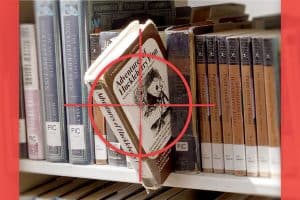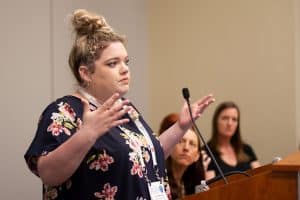
As she compiled data on challenges to library materials for National Library Week last year, Kristin Pekoll, assistant director of the American Library Association’s (ALA) Office for Intellectual Freedom (OIF), noticed an odd trend: public libraries were nearly tied with school libraries in the frequency of challenges.
“That didn’t necessarily make sense to me because most public libraries are well prepared to deal with challenges,” she says, pointing to the popularity of Banned Books Week (this year September 22–28) and the array of resources OIF provides for librarians dealing with book challenges. “When I went back and looked just at public libraries, I was seeing a huge rise in challenges to nonbook materials,” such as displays, social media posts, reading lists, and programs. (About half of the challenged programs were drag queen story hours). In 2018, these nonbook challenges represented 38% of challenges reported to OIF.
Since then, Pekoll has worked to bring awareness of these types of challenges to the broader discussion around censorship and intellectual freedom. She is author of Beyond Banned Books: Defending Intellectual Freedom Throughout Your Library (ALA Editions, 2019) and led a well-attended panel discussion on the topic at ALA’s 2019 Annual Conference in Washington, D.C.
“Libraries are collecting and doing so much more with different types of resources—the library of things, collections of tools and sewing machines, clothes you can check out for job interviews, so many new ideas—without the same forethought about potential challenges,” Pekoll says. “The book is a resource to remind libraries programs and displays are just as important as what’s on the shelves, they are protected by the First Amendment, and there is guidance and support available.”
Controversy on display
Laura Broderick, senior children’s librarian at Pikes Peak Library District in Colorado Springs, Colorado, was only five months into her library career when she attended her first ALA event, the 2018 ALA Midwinter Meeting & Exhibits in Denver. She was deeply moved by Opening Session speaker Patrisse Cullors, cofounder of the Black Lives Matter movement, and returned to her library eager to apply what she’d learned.
It was mid-February, and the children’s section of the Library 21C branch where she worked already had a display in place for Black History Month.
“It struck me as a perfect opportunity to add a Black Lives Matter display, filled with contemporary books by black authors and featuring black characters, to remind patrons that civil rights isn’t a thing of the past,” she recalls. “It didn’t even refer specifically to the issue of police brutality, and it still managed to offend people.”
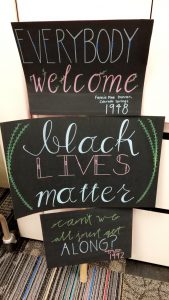
Despite anecdotal accounts of positive responses, particularly from black patrons and families, one patron spoke up. “A police officer had recently been killed in our city, and this patron expressed that she felt the display was promoting violence against police, which is itself a misconception about Black Lives Matter,” Broderick says. “I don’t see ignorance as a bad thing; it’s an opportunity for people to learn. We hoped this would be an opportunity for learning, but it quickly escalated to a point where I don’t think she was really listening.”
Though her supervisors were taken aback, Broderick’s administration supported her work. She met with her supervisors and the library director, who suggested amending the display to add context rather than simply taking down the controversial component. “It’s important for us to reflect the diverse communities we serve,” Broderick says. “We added two quotes to the display, one from a local civil rights activist and a quote from Rodney King, to put Black Lives Matter in the context of the ongoing fight for civil rights.” This compromise failed to satisfy the patron who brought the complaint, but it underscored important lessons for Broderick. She says she learned to balance passion for social issues with humility and empathy, and to work proactively with administration to get ahead of potential points of controversy.
“Every year we have a display for Pride Month in the children’s departments of our libraries, and every year we hear the same complaints,” she says. “But the managers are better prepared and more confident now that we’ve thought through the possibilities.”
Broderick’s experience jibes with broader trends in censorship of books and nonbook materials, Pekoll says. “We see a lot of identity issues at the heart of these challenges: culture, race, sexual orientation, gender identity, issues about how people experience the world. And we see a lot of marginalized communities being kept at the margins,” she says. “When programs are canceled, when displays and reading lists are eliminated, people don’t see it as censorship, they see it as avoiding controversy. But it sends a powerful message to underrepresented communities that they are somehow inappropriate, that their voice doesn’t count.”
When your critics have a point
With 25 years of library experience under belt, including 15 at a school library and five at a public library, Lisa Von Drasek has experienced her fair share of book challenges. But she hadn’t expected to court controversy in her current role—she is now associate librarian and curator of the Children’s Literature Research Collections at University of Minnesota—as challenges are fewer in academic libraries.
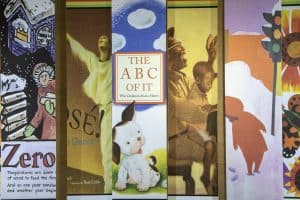
Earlier this year she organized “The ABC of It: Why Children’s Books Matter,” an exhibit commemorating the 70th anniversary of the Kerlan Collection, which includes such rare materials as the original artwork for Goodnight Moon and the manuscript for Wanda Gág’s Millions of Cats. She paired the materials with commentary from children’s literature expert Leonard Marcus.
“We placed Dr. Seuss’s The Cat in the Hat in the exhibit because it had to do with the transformation in children’s book publishing and teaching children to read through trade books,” she says. Some critics objected to this placement, on the grounds that the author and illustrator has been linked to racist imagery.
Von Drasek, pointing to works like Philip Nel’s Was the Cat in the Hat Black?: The Hidden Racism of Children’s Literature, and the Need for Diverse Books, had anticipated some critical comments. “These are valued issues for discussion, and it was part of my teaching notes to bring these things to light. I didn’t expect to encounter demands for removal, as well as revision of the signage and exhibit catalog. Some people wished me to make a public apology.”
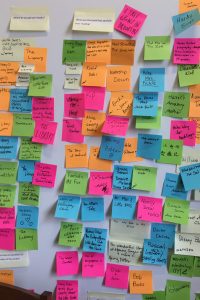
As with Broderick in Colorado, Von Drasek’s administration supported her work and counseled her on weathering the storm. She also drew strength from resources and perspectives from the library community, including the “Censorship Beyond Books” session at Annual in June. “I was so surprised listening to these librarians speak about their experiences,” she says. “When we encounter book challenges, we listen and try to understand the point of view of the person who brought the challenge, we explain what intellectual freedom is and why it’s part of the core of our work, and demonstrate how they can make their voices heard by following the proper procedure. It had never occurred to me to apply that procedure and policy to an exhibit.”
“I also learned to be prepared, to have a collection development policy in place for all types of materials,” she says. “Anyone could take exception to any form of communication, so when that happens, you need to know your next right move. People will be critical, and we welcome our critical friends because we also recognize their intellectual freedom. I’m still their librarian, no matter what.”
Subtler censorship
As the only credentialed librarian working at Lake Oswego (Oreg.) School District, District Librarian Miranda Doyle understands that school libraries are still the most frequent targets of successful book challenges—meaning that the challenge results in removal of materials. She’s also observed that this trend can creep into reading lists and events centered around books.
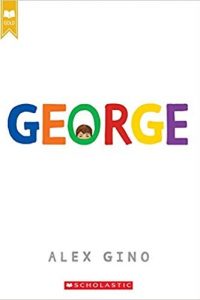
In her capacity as intellectual freedom chair of the Oregon Association of School Libraries, Doyle witnessed a challenge to the annual Oregon Battle of the Books event, where teams of students across the state read an assortment of preselected books. The 2018 list of titles included George, the 2015 novel by Alex Gino, with a young transgender student at its center—and parents’ objections generated national news coverage.
Even if a challenge seems to involve a book, Doyle warns against subtler forms of censorship in school libraries, such as authors who find their topics or audiences limited by administrators and the urge to anticipate controversy and self-censor.
“We censor ourselves by not putting certain books or materials on display, knowing they might be controversial,” she says. “When that happens, we’re not allowing students to see we have books that may benefit them, that reflect their experiences.”
OIF’s Pekoll urges librarians dealing with challenges to nonbook materials to reach out to OIF and consult the resources on ALA’s website. “Even if you’re not sure what qualifies as a challenge, or if you don’t know how to handle the challenge, give us a call and we can walk you through it,” she says. “We’ve pretty much seen it all, but if we haven’t, then we want to be surprised. That’s how we discover trends.”

